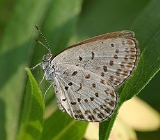
Pseudozizeeria maha
Encyclopedia
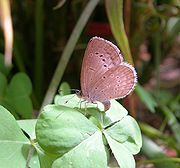
The Pale Grass Blue is a small butterfly
Butterfly
A butterfly is a mainly day-flying insect of the order Lepidoptera, which includes the butterflies and moths. Like other holometabolous insects, the butterfly's life cycle consists of four parts: egg, larva, pupa and adult. Most species are diurnal. Butterflies have large, often brightly coloured...
found in Asia that belongs to the Lycaenids or Blues
Lycaenidae
The Lycaenidae are the second-largest family of butterflies, with about 6000 species worldwide, whose members are also called gossamer-winged butterflies...
family.
Wet-season brood
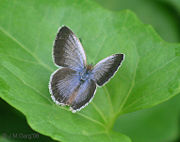
Underside: brownish grey. Fore wing: a spot in cell, a transverse lunule on the discocellulars, and a transverse anteriorly inwardly curved series of eight discal spots, black; the transverse lunule and each spot encircled with a narrow white edging ; the posterior two spots of the discal series geminate. Beyond these are a postdiseal and a subterminal series of short transverse dusky black spots followed by an anticiliary black line; the ground-colour between the discal and postdiscal series and between the latter and the subterminal series of spots posteriorly paler than on the rest of the wing. Hind wing: a transverse, subbasal, slightly sinuate line of four spots, a short, slender, lunular line on the discocellulars, and a very strongly curved discal series of eight small spots, black; the lunule and each spot encircled with a narrow edging of white; the posterior two spots of the discal series geminate as on the fore wing; beyond these as on the fore wing there is a double line of dusky spots, only more lunular, with between them and between the discal and postdiscal series the ground-colour in the same way followed by slightly paler; an anticiliary fine black line. Cilia of both fore and hind wings whitey brown, darker anteriorly on the fore wing. Antennae, head, thorax and abdomen dark brown, shafts of the antennae ringed with white; in fresh specimens the thorax and abdomen with a little light blue pubescence; beneath: palpi, thorax and abdomen white.
Female Upperside: brownish black; the basal halves of the wings slightly suffused with light blue, anticiliary black lines on both fore and hind wings, and on the latter wing an obscure subterminal series of spots as in the male. Underside, similar,only the ground-colour darker, the markings larger and more clearly defined. Antennae, head, thorax and abdomen as in the male, but with no blue pubescence on the thorax and abdomen on the upperside.
Dry-season brood
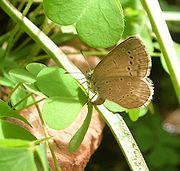
.jpg)

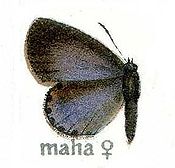
Antenna, head, thorax and abdomen similar to those of the male.
Food plants
The eggs are laid on the host plants and the larvae hatch to feed on them. The plants include members of the OxalidaceaeOxalidaceae
The Oxalidaceae, or wood sorrel family, are a small family of eight genera of herbaceous plants, shrubs and small trees, with the great majority of the 900 species in the genus Oxalis...
including Oxalis corniculata, some Leguminosae and Acanthaceae
Acanthaceae
The family Acanthaceae is a taxon of dicotyledonous flowering plants containing almost 250 genera and about 2500 species....
.
Other studies
A study in Japan used this species to detect the side-effects of transgenic Bt corn, particularly by way of pollen falling onto leaves of the Oxalis host plants. No significant effect was found in that study.General reading
- Evans, W.H. (1932) The Identification of Indian Butterflies. (2nd Ed), Bombay Natural History Society, Mumbai, India
- Gaonkar, Harish (1996) Butterflies of the Western Ghats, India (including Sri Lanka) - A Biodiversity Assessment of a threatened mountain system. Journal of the Bombay Natural History Society.
- Gay,Thomas; Kehimkar,Isaac & Punetha,J.C.(1992) Common Butterflies of India. WWF-India and Oxford University Press, Mumbai, India.
- Haribal, Meena (1994) Butterflies of Sikkim Himalaya and their Natural History.
- Kunte,Krushnamegh (2005) Butterflies of Peninsular India. Universities Press.
- Wynter-Blyth, M.A. (1957) Butterflies of the Indian Region, Bombay Natural History Society, Mumbai, India.
External links
- Asahi Correctly determined photos of Zizina maha (synonym) specimens from the PhilippinesPhilippinesThe Philippines , officially known as the Republic of the Philippines , is a country in Southeast Asia in the western Pacific Ocean. To its north across the Luzon Strait lies Taiwan. West across the South China Sea sits Vietnam...
.

